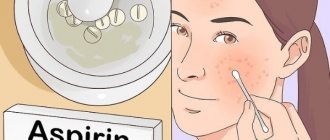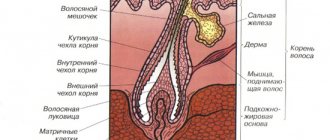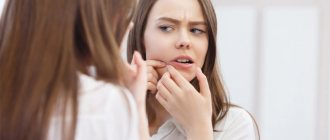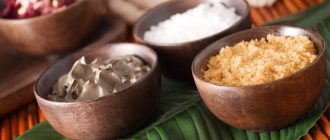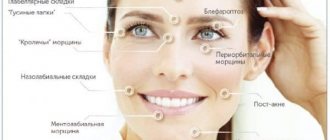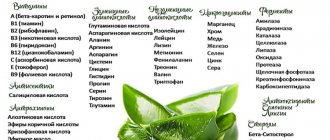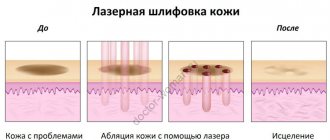Aloe is a unique plant that was successfully used for treatment and cosmetic purposes by our great-grandmothers. It has been successfully used both for hair care and for facial skin treatment.
Thanks to its antibacterial and cleansing properties, this plant, or rather, masks and lotions based on it, do an excellent job with acne, pimples, ulcers, scars and scars remaining after them, as well as with other problems that concern many girls and boys, especially in adolescence.
Does aloe help with acne?
To understand how effective the use of agave is against acne, you should consider its composition and properties. The active components are concentrated in the leaves.
A total of 75 potentially active substances: vitamins, enzymes, salicylic acids, fatty acids and others.
- Retinol, ascorbic acid, tocopherol are powerful antioxidants. They suppress the growth of pathogenic microorganisms.
- Bradykinase (an enzyme) helps reduce excessive inflammation when applied topically to the affected dermis.
- Alonine and emodin (anthraquinones) have antibacterial and antiviral effects. Protect epidermal cells from damage by pathogenic bacteria and viral agents.
- Auxins and gibberellins (hormones) have an anti-inflammatory effect and help in wound healing.
The juice creates an invisible film on the face, retaining nutrients inside the dermal cells and preventing the penetration of bacteria. Agave not only effectively fights acne, but also prevents its occurrence.
Benefits for the skin
The healing properties for the face are as follows:
- Formation of a protective film on the epidermis, which prevents the penetration of pathogenic microorganisms into the dermis;
- Cleansing and deep moisturizing of the skin;
- Strengthening blood microcirculation, thereby increasing oxygen supply to the epidermis;
- Elimination of inflammation and reduction of reddened areas;
- Narrowing of pores;
- Suppression of the activity of bacteria and microbes;
- Activation of cell regeneration processes;
- Saturation of tissues with useful elements;
- Strengthening local metabolism;
- Stimulating the synthesis of elastin and collagen fibers;
- Maintaining the balance of fluid and salt in the skin.
Use Cases
Agave is a hypoallergenic plant and interacts well with various substances. These properties allow it to be used in different ways.
Many cosmetic products are prepared based on sabur:
- Compresses draw out dirt and bacteria from the pores. Reduce inflammation, relieve swelling. Applications are applied for at least half an hour, and for severe rashes - overnight. The procedures are carried out daily until the desired result is achieved.
- Tonics and lotions are used to prevent acne.
- Masks nourish, moisturize the epidermis, stimulate regeneration processes.
- Ointments and creams. The use of homemade emulsions helps restore the water-electrolyte balance of the epidermis and reduce irritation.
The remedies are selected based on the severity of the rash and the desired effect.
Be sure to read:
The best film masks for blackheads at home: how to make, application rules
Does the plant help in the fight against acne?
Yes. A rather trivial, seemingly indoor plant has many functions. Of course, each person and each case is individual, so in any case you need to try the effect of aloe on yourself before drawing firm conclusions.
But statistics show that treating acne with aloe gives excellent results. Moreover, this method of treatment is considered extremely safe, so it is perfect for both adults and children.
How exactly?
- It disinfects, preventing inflammatory processes from spreading over the surface of the face.
- Removes redness.
- Reduces the number of rashes.
- Prevents the phenomenon of post-acne.
Compresses and lotions
For severe rashes with purulent contents, compresses should be applied. Applications, penetrating deep into the pores, draw out purulent exudate, relieve inflammation, and soothe irritated dermis.
For compresses, the leaves are used either alone or in combination with other components.
- The pulp of the plant is lightly kneaded on a gauze napkin. Fold the gauze in half so that the paste does not fall in and apply it to the face for at least half an hour. It is recommended to apply compresses to problem areas at night, securing them with adhesive tape.
- Squeeze the juice from the young shoots and mix with olive oil in a 1:1 ratio. A napkin is moistened in the prepared solution and applied to the inflamed area.
Pustular elements are more often observed in women with oily skin. The secretion of the sebaceous glands is a breeding ground for pathogens, and its excess accelerates the proliferation of bacteria. Girls with oily dermis need to treat their face with lotion every day.
To prepare the lotion, take 2 teaspoons of calendula infusion and add 3 tsp. juice of a medicinal plant. The prepared solution is used to treat inflamed lesions 2-3 times a day.
Using homemade lotion for preventive purposes will help prevent the occurrence of acne and get rid of oily sheen.
Contraindications and possible harm
External use of aloe is contraindicated in case of individual intolerance and the presence of neoplasms on the skin.
Before using any composition, you should check your skin's reaction to it. You will need to apply a small amount of product to your wrist for 8-10 minutes. If after 24 hours no negative reactions appear (redness, burning, itching, irritation, etc.), the mixture can be used.
Products containing alcohol are not recommended for dry and sensitive skin.
Scrubs are used only to prevent the appearance of rashes. If there is a large number of acne, their use may aggravate the situation.
Treating the skin with ice cubes is contraindicated if:
- allergies to cold;
- rosacea;
- nearby vessels;
- excessively dry and sensitive skin.
You should also avoid the procedure during the cold season.
For oily skin, use aloe oil with caution.
Rubbing your face with aloe juice
To maintain elasticity and normal humidity, it is recommended to wipe the dermis daily with sabur. The saponins it contains have a mild irritant effect, stimulating the secretion of all glands, which helps cleanse the dermis of dirt and toxins. Glucomannan, rich in mannose and gibberellin, interacts with growth factor receptors on fibroblasts, which significantly increases collagen synthesis.
Daily rubbing soothes, moisturizes the skin, and prevents flaking in harsh and dry weather. The oligoelements present in the leaves are recognized as powerful oxidants and cellular anti-aging agents. Rubbing will help maintain skin tone, keep it healthy and youthful. But only freshly cut shoots should be used for the procedure.
Mechanism of action
The effectiveness of aloe against acne on the face is due to the plant’s effects in the following areas:
- When introduced into the body, emollients reduce swelling and reduce pain of various types;
- The active ingredients expand the skin capillaries, thereby improving blood flow and delivering more oxygen to the dermis;
- Biogenic stimulants provide increased adaptability of body systems, in particular skin tissue, to the most unfavorable external conditions;
- The healing effect in combination with the bactericidal effect allows even purulent wounds to heal quickly.
Aloe face mask for acne
About 86% of manufactured cosmetic masks contain agave as a main component. The products have a whitening, bactericidal, anti-inflammatory effect. You can also make an anti-acne mask at home.
Be sure to read:
The best recipes for face masks with egg: how to make at home, how to apply
The recipes include only natural ingredients, and preparation does not take much time.
- Egg white is mixed with two tablespoons of plant pulp.
- Add 1 tsp. lemon, stir.
- The mixture is applied to the face with a soft brush and left until completely dry.
- Wash with warm water.
The mask will relieve inflammation, cleanse pores, and remove excess secretion from the sebaceous glands.
Properties of a flower
In addition, the plant has a unique composition, thanks to which it boasts the following healing properties based on:
- mineral salts;
- microelements;
- vitamins A, C, E, group B;
- organic acids, which, in addition to directly combating acne, are able to regenerate tissue damaged by inflammation;
- tannins - phenols;
- carotenoids that relieve redness and inflammation;
- catechins, which normalize blood circulation and provide the skin with oxygen;
- pectin, which has moisturizing and cleansing properties;
- aloin is the main substance that creates the necessary barrier, which prevents external factors from catalyzing the appearance of acne.
But do not rush to use agave as one of the main remedies against rashes without thoroughly studying all its nuances.
For example, if you overdose on aloin contained in the leaves of the plant, you can do yourself more harm than good. Therefore, you should not regularly abuse the properties of agave. This can harm both the skin and the entire body.
Aloe for blackheads
The evergreen shrub effectively fights comedones. The oily liquid of the leaves dissolves sebaceous plugs and deeply cleanses the excretory ducts. Reduces irritation, tightens pores, preventing the accumulation of dirt, bacteria and the appearance of new blackheads.
To treat comedones, you can use self-prepared tonics and masks:
- Add 1 tbsp to cosmetic tonic (50 ml). l freshly squeezed oily liquid of the plant. Soak a cotton pad in the solution and treat problem areas in the morning and evening.
- White clay (1 tbsp) is dissolved in 50 ml of mineral water and mixed with sabur. The mixture is applied to areas with blackheads for 20 minutes.
Clay absorbs dirt and excess fatty substances secreted by the sebaceous glands. Use in combination with agave will help avoid drying out the epidermis.
Is it relevant to use aloe for post-acne?
Medical research has shown that agave juice is effective in healing serious burns by stimulating collagen production. It is this substance that is necessary to smooth out the dermis covered with scars.
To get rid of stains, you need to lubricate the problem areas with the pulp or squeezed fresh juice of the plant until the post-acne is completely eliminated. The procedure should be performed twice a day. Compresses with agave liquid are also suitable, which should be kept for about 10 minutes.
How to use aloe against acne?
A good effect can be achieved only if you follow the rules for using a medicinal flower.
- It is better to select a plant older than 3 years; the older, the greater the concentration of useful elements.
- Before use, cut shoots are washed under running water.
- Leaves are stored in the refrigerator in parchment paper for no more than 2 weeks.
- I test ready-made mixtures for allergies.
It is recommended to use freshly prepared formulations.
Preparation of raw materials
Proper preparation of raw materials is very important. At this stage, a base is formed, the basis of a useful mixture or mask. The main thing here is to choose the right leaves.
There are several simple rules for selection and preparation:
- You need to choose the thickest, fleshiest leaves, slightly dried out at the ends, but without visible damage. There should be no signs of rotting;
- To obtain the most beneficial juice, the plant should be stopped watering 10 days before cutting;
- Leaves must be cut off near the stem, closer to the ground;
- Rinse with plenty of warm, running water;
- Dry;
- Wrap in paper or cotton cloth;
- Place in the refrigerator for 10 - 14 days. Leaves should be placed so that they are as far away from the freezer as possible;
- After the required period has passed, the leaves must be removed;
- Throw away those that have shriveled or darkened;
- Rinse others again, remove thorns and thick skin;
- Squeeze thoroughly until the juice releases. You can squeeze it manually or using a meat grinder.;
- Be sure to strain the juice through cheesecloth;
- Pour into bottles, preferably dark glass;
- Store in the refrigerator or in a cool place away from sunlight;
- The juice retains its beneficial properties for 10-14 days, so it should be used as a medicine against acne as quickly as possible.
The juice must be prepared no later than 3 hours after unloading the plant leaves from the refrigerator. When using a meat grinder, the primary mass should be put in the refrigerator for an hour and a half and only then squeezed out, and through double gauze.
This way you can get biostimulated juice, which is much healthier for the skin.
Universal remedy with aloe for acne
Homemade recipes may contain ingredients that cause allergies (honey, herbs). This becomes the reason for refusing to use alternative cosmetics.
But among the numerous recipes there are also universal ones, containing hypoallergenic components and suitable for any skin type.
- In highly carbonated mineral water (50 ml) dilute 2 tbsp. l. Sabura.
- Add 3 drops of hydrogen peroxide to the solution.
- The composition is applied to the skin twice a day.
It is better to take medicinal-table mineral water, for example, “Essentuki 17”.
What is Aloe Vera?
For home remedies, 2 types of plants are used - Aloe Vera and Agave. They differ only in appearance, their beneficial properties are identical. When taken orally, a distinct bitterness is felt.
The fleshy leaves filled with gel-like contents are valuable for medicine and cosmetology. Aloe contains:
- Pectins;
- Carotenoids;
- Aloin;
- Catechins;
- Phenols;
- Extensive complex of vitamins;
- Organic acids;
- Mineral salts;
- A small amount of microelements.
Reviews
- Margarita, 28 years old: “Aloe juice is simply my savior. Before, I didn’t know whether it was helping or not. I have naturally problematic skin, so it always suffers from various rashes. After visiting the doctor and completing the prescribed course, I realized that the expected effect had happened. I decided to act on my own, used masks based on this product, and prepared a decoction for wiping. The course of my therapy was 2 months. During this time, I achieved amazing results: my pores narrowed, acne and pimples disappeared, my skin became matte and healthy.”
- Alevtina, 54 years old: “Due to a hormonal imbalance, rashes began to appear on my face, and the number of acne increased every day. I decided to surf the Internet and found an effective aloe-based product. I made a mask with plant juice and egg white. I performed this manipulation 2 times a week for a month. The positive effect was noticeable after a week. My skin cleared up, became healthy and fresh.”
- Christina, 19 years old: “Aloe juice is a unique product that allows you to eliminate inflammation on the skin in a short period of time. I have acne quite often, so I always need to take care of my facial skin. For these purposes, I use homemade aloe-based cosmetics. First, I cleanse the skin, then apply my mask with aloe and essential oils, and then wipe the skin with a decoction of the leaves. I have been using this treatment regimen for 1.5 months now, and during this time my skin has noticeably renewed itself, become cleaner and softer.”
Aloe is a unique plant because it has a wide range of effects. If we sat down to talk about acne and inflammation on the face, then aloe is like an ambulance that quickly and effectively eliminates problems on the face and body. In addition to home remedies, you can use ready-made aloe-based formulations, which you can buy in stores.
Can the plant cause harm?
There are a number of situations when it is not recommended to use aloe for acne. Avoid lubricating the dermis with products containing agave gel when:
- Neoplasms of any etiology on the skin;
- Individual intolerance to the plant;
- Particular allergic skin reactions;
- A significant amount of hair;
- Pregnancy and breastfeeding;
- Spider veins on the dermis.
It is also worth stopping treatment with agave during menstruation.
